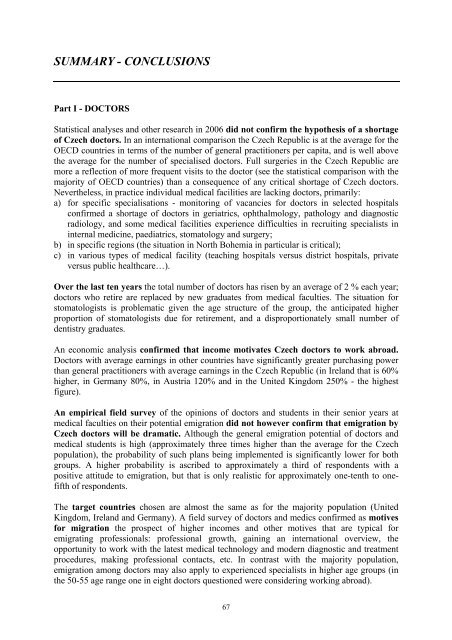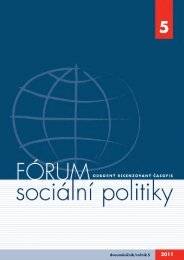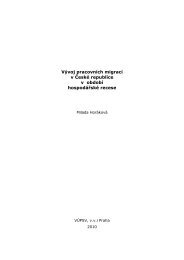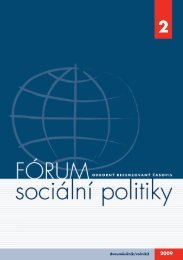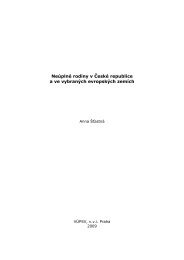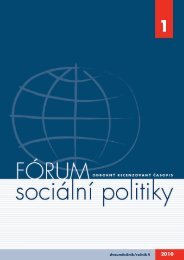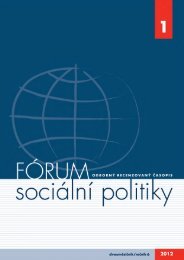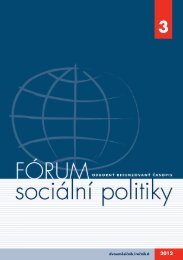The Risk of the Outflow of Doctors and IT/ICT ... - Outlook Web App
The Risk of the Outflow of Doctors and IT/ICT ... - Outlook Web App
The Risk of the Outflow of Doctors and IT/ICT ... - Outlook Web App
You also want an ePaper? Increase the reach of your titles
YUMPU automatically turns print PDFs into web optimized ePapers that Google loves.
SUMMARY - CONCLUSIONS<br />
Part I - DOCTORS<br />
Statistical analyses <strong>and</strong> o<strong>the</strong>r research in 2006 did not confirm <strong>the</strong> hypo<strong>the</strong>sis <strong>of</strong> a shortage<br />
<strong>of</strong> Czech doctors. In an international comparison <strong>the</strong> Czech Republic is at <strong>the</strong> average for <strong>the</strong><br />
OECD countries in terms <strong>of</strong> <strong>the</strong> number <strong>of</strong> general practitioners per capita, <strong>and</strong> is well above<br />
<strong>the</strong> average for <strong>the</strong> number <strong>of</strong> specialised doctors. Full surgeries in <strong>the</strong> Czech Republic are<br />
more a reflection <strong>of</strong> more frequent visits to <strong>the</strong> doctor (see <strong>the</strong> statistical comparison with <strong>the</strong><br />
majority <strong>of</strong> OECD countries) than a consequence <strong>of</strong> any critical shortage <strong>of</strong> Czech doctors.<br />
Never<strong>the</strong>less, in practice individual medical facilities are lacking doctors, primarily:<br />
a) for specific specialisations - monitoring <strong>of</strong> vacancies for doctors in selected hospitals<br />
confirmed a shortage <strong>of</strong> doctors in geriatrics, ophthalmology, pathology <strong>and</strong> diagnostic<br />
radiology, <strong>and</strong> some medical facilities experience difficulties in recruiting specialists in<br />
internal medicine, paediatrics, stomatology <strong>and</strong> surgery;<br />
b) in specific regions (<strong>the</strong> situation in North Bohemia in particular is critical);<br />
c) in various types <strong>of</strong> medical facility (teaching hospitals versus district hospitals, private<br />
versus public healthcare…).<br />
Over <strong>the</strong> last ten years <strong>the</strong> total number <strong>of</strong> doctors has risen by an average <strong>of</strong> 2 % each year;<br />
doctors who retire are replaced by new graduates from medical faculties. <strong>The</strong> situation for<br />
stomatologists is problematic given <strong>the</strong> age structure <strong>of</strong> <strong>the</strong> group, <strong>the</strong> anticipated higher<br />
proportion <strong>of</strong> stomatologists due for retirement, <strong>and</strong> a disproportionately small number <strong>of</strong><br />
dentistry graduates.<br />
An economic analysis confirmed that income motivates Czech doctors to work abroad.<br />
<strong>Doctors</strong> with average earnings in o<strong>the</strong>r countries have significantly greater purchasing power<br />
than general practitioners with average earnings in <strong>the</strong> Czech Republic (in Irel<strong>and</strong> that is 60%<br />
higher, in Germany 80%, in Austria 120% <strong>and</strong> in <strong>the</strong> United Kingdom 250% - <strong>the</strong> highest<br />
figure).<br />
An empirical field survey <strong>of</strong> <strong>the</strong> opinions <strong>of</strong> doctors <strong>and</strong> students in <strong>the</strong>ir senior years at<br />
medical faculties on <strong>the</strong>ir potential emigration did not however confirm that emigration by<br />
Czech doctors will be dramatic. Although <strong>the</strong> general emigration potential <strong>of</strong> doctors <strong>and</strong><br />
medical students is high (approximately three times higher than <strong>the</strong> average for <strong>the</strong> Czech<br />
population), <strong>the</strong> probability <strong>of</strong> such plans being implemented is significantly lower for both<br />
groups. A higher probability is ascribed to approximately a third <strong>of</strong> respondents with a<br />
positive attitude to emigration, but that is only realistic for approximately one-tenth to onefifth<br />
<strong>of</strong> respondents.<br />
<strong>The</strong> target countries chosen are almost <strong>the</strong> same as for <strong>the</strong> majority population (United<br />
Kingdom, Irel<strong>and</strong> <strong>and</strong> Germany). A field survey <strong>of</strong> doctors <strong>and</strong> medics confirmed as motives<br />
for migration <strong>the</strong> prospect <strong>of</strong> higher incomes <strong>and</strong> o<strong>the</strong>r motives that are typical for<br />
emigrating pr<strong>of</strong>essionals: pr<strong>of</strong>essional growth, gaining an international overview, <strong>the</strong><br />
opportunity to work with <strong>the</strong> latest medical technology <strong>and</strong> modern diagnostic <strong>and</strong> treatment<br />
procedures, making pr<strong>of</strong>essional contacts, etc. In contrast with <strong>the</strong> majority population,<br />
emigration among doctors may also apply to experienced specialists in higher age groups (in<br />
<strong>the</strong> 50-55 age range one in eight doctors questioned were considering working abroad).<br />
67


